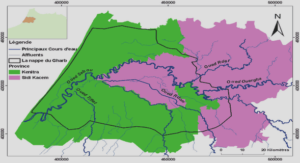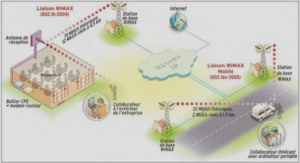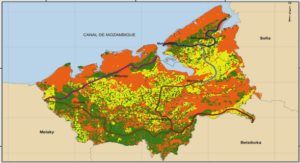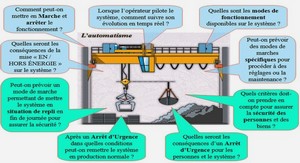Etude de quelques classes d’équations différentielles d’ordre fractionnaire
Fractional calculus started with some attempts by Leibniz in 1695 and 1697 and was developed until recent years (see [61,75,77]), due to the fact that differential equations of noninteger order can represent the dynamics of various memory systems and arise from a variety of applications, including several fields of science and engineering such as geology, physics, optics, chemistry, biology, economics, signal and image processing,… Although the literature on fractional differential equations is now vast, more studies are needed. Recently, the investigation of the qualitative properties of solutions to fractional initial and boundary value problems has attracted the attention of many authors [5,73], and different tools are used in these researches, such as the method of upper and lower solutions, the variational method, the coincidence degree theory, the fixed point theorems … In the last few years, many researchers studied linear and nonlinear boundary value problems involving both the right Caputo and the left Riemann-Liouville fractional derivatives, and they used several methods. By the help of operational method and the successive approximations, some linear differential equations containing left and right fractional derivatives that may appear in fractional variational calculus, are studied in [26,32]. Recently, the method of upper and lower solutions is applied in [51,63,64] to solve nonlinear differential equations containing mixed fractional derivatives. The main objective of this thesis is to study nonlinear boundary value problem with right and left fractional derivatives in different functional spaces This thesis is divided into five chapters as follows: In Chapter 1, we introduce definitions, basic properties of fractional calculus, functional spaces the L p spaces, Sobolev spaces, and some fixed point theorems. In Chapter 2, we the study of the existence of solutions for the following nonlinear boundary value problem involving both the right Caputo and the left Riemann-Liouville fractional derivatives: − C D α 1− D β 0+ u(t) + ω 2u(t) + f(t, u(t)) = 0 , t ∈ J = [0, 1]. (1) D β 0+ u(1) = 0 , u(0) = 0 (2) where 0 < α, β < 1, α+β > 1, ω ∈ R, CDα 1− and D β 0+ denote respectively the right Caputo derivative and the left Riemann Liouville derivative, u is the unknown function and f : J × R −→ R is a Caratheodory function. By Krasnoselskii fixed point theorem, we prove the existence of solution for problem (1)-(2).The results of this chapter are published: H. Moffek, A. Guezane-Lakoud, Existence of solutions to a class of nonlinear boundary value problems with right and left fractional derivarives, AIMS Mathematics, 5(5): 4770-4780 (2020) Chapter 3, we discuss the existence and uniqueness of solutions for fractional differential equations with multipoint boundary value conditions: D α 0+ u(t) + f(t, u(t)) + g(t, Dα−1 0+ u(t)) = 0 , t ∈ J = [0, 1]. (3) u(0) = 0, , Dβ 0+ u(1) = Xm k=1 ξkD β 0+ u(ηk). (4) 1 Introduction where 1 ≤ α ≤ 2, 0 ≤ β ≤ 1, 0 < α − β − 1, 0 < ξk, ηk < 1, k = 1..m − 1, denotes D β 0+ the left Riemann-Liouville , u is the unknown function and f, g : J × R+ −→ R are given continuous functions . We get a result with Banachs fixed point theorem ,Krasnoselskii fixed point theorem and LeraySchauder nonlinear alternative. By Krasnoselskii fixed point theorem, we prove the existence of solutions for fractional differential equations with multipoint boundary value conditions in a fractional Sobolev space : D α 0+ u(t) + f(t, u(t)) + g(t, Dβ 0+ u(t)) = 0 , t ∈ J = [0, 1]. (5) D (α−i) 0+ u(0) = 0, i = 2…n, Dβ 0+ u(1) = Xm k=1 ξkD β 0+ u(ηk). (6) where n − 1 ≤ α ≤ n, n ≥ 4 , 0 ≤ β ≤ 1, 0 < ξk, ηk < 1, k = 1..m − 1, denote D β 0+ the left Riemann-Liouville, u is the unknown function and f, g : J × R+ −→ R are given Caratheodory functions . Chapter 4, this chapter investigates the existence of solutions for a nonlinear fractional oscillator equation with both left and right Caputo fractional derivatives subject to nonlocal conditions. − CD α 1− CD β 0+ u(t) + ω 2u(t) + f(t, u(t), Dβ 0+ u(t)) = 0 , t ∈ J = [0, 1]. (7) CD β 0+ u(1) = 0 , u(0) = g(u) , u0 (0) = h(u). (8) where 0 < α < 1, 1 < β < 2, ω ∈ R, CDα 1− , CD β 0+ denote the right and left Caputo derivative respectively, denotes D β 0+ the left Riemann-Liouville, f : J × R 2 −→ R is a continuous function, and g, h : C(J, R) −→ R are continuous functions. We use the Krasnoselskiis fixed point theorem. Chapter 5, Concerns the existence of solutions for a boundary value problem for a nonlinear fractional oscillator equation with both left Riemann-Liouville and right Caputo fractional derivatives, of the form: − CD α 1− D β 0+ u(t) + ω 2u(t) + f(t, ut) = 0 , t ∈ J = [0, 1]. (9) CD β 0+ u(1) = 0 , u(t) = φ(t), t ∈ [−d, 0]. (10) where 0 < α < 1, 0 < β < 1, ω ∈ R, CDα 1− denotes the right Caputo derivative, denotes D β 0+ the left Riemann-Liouville, u is the unknown function, f : J × C([−d, 0], R) −→ R is a continuous function, and φ ∈ C([−d, 0], R) with φ(0) = 0. For any continuous function u defined on [−d, 1] and any t ∈ J, we denote by ut the element of C([−d, 0], R) defined by ut(τ ) = u(t + τ ), τ ∈ [−d, 0]. Here ut(·) represents the history of the state from time (t − d) up to the present time t. The Banach fixed point theorem is used to prove the existence and uniqueness of solutions of the problem (9)-(10), then we apply Leray-Schauder fixed point theorem to conclude the existence of nontrivial solutions.
Special functions
We provide definitions and some properties of the gamma function and the beta function These two functions play a very important role in the theory of fractional calculus.(see [78]). The Gamma function Definition 1 The Gamma function Γ(.) is defined by Γ(z) = Z +∞ 0 e −t t z−1 dt, (Re(z) > 0) This integral is convergent for any complex z ∈ C such that (Re(z) > 0). Proposition 2 The Gamma function satisfies 1) Γ(z + 1) = zΓ(z) (Re(z) > 0) and for any integer n ≥ 0, we have Γ(n + 1) = n! ∼ √ 2πnnn e −n (Stirling0 s formula) 2) Γ (n) (z) = Z +∞ 0 e −t t z−1 logn (t)dt, 3) Γ(x) lim n→+∞ n!n x x(x + 1)…(x + n) ; x > 0. 4) 1 Γ(x) = xeγx Y +∞ n=1 (1 + x n )e −x n , (Weierstrass formula), where γ = 05772… is Euler’s constant 5) 1 Γ(x)Γ(1 − x) = x Y +∞ n=1 (1 − x 2 n2 ) 6) Γ(x)Γ(1 − x) = π sin(πx) 3 Chapter 1 Preliminaries 7) Γ(x)Γ(x + 1 2 ) = √ π 2 2x−1 Γ(2x) (Legendre formula) 8) Γ(x)Γ(x + 1 n )Γ(x + 2 n )…Γ(x + n − 1 n ) = (2π) n−1 2 n 1 2 −nxΓ(nx), (Gauss formula). Some special values of Γ(.) 1) Γ(1 2 ) = √ π 2) Γ(n + 1 2 ) = 1.3.5…(2n − 1) 2 n √ π, n ∈ N, 3) Γ(n + 1 3 ) = 1.4.7…(3n − 2) 3 n Γ(1 3 ), n ∈ N, 4) Γ(n + 1 4 ) = 1.5.9…(4n − 3) 4 n Γ(1 4 ), n ∈ N, The Beta function Definition 3 The beta function is given by B(z, w) = Z 1 0 t z−1 (1 − t) w−1 dt, (Re(z) > 0, Re(w) > 0). Proposition 4 1) B(z, w) = Γ(z)Γ(w) Γ(z + w) , 2) B(z, w) = B(w, z), 3) B(z + 1, w) = z z + w B(z, w) 4) B(x, 1 − x) = π sin(πx) , x > 0 5) B(x, 1) = 1 x 6) B(x, n) = (n − 1)! x(x + 1)…(x + n − 1), n ≥ 1. I.2 Fractional integrals and fractional derivatives We introduce concepts about fractional calculus and will focus on the Riemann-Liouville integral, and Riemann-Liouville and Caputo derivatives and the relationship between them. We support this chapter with some examples (see[44,61,75,77]) Definition 5 ([61,75]) Let J = [a , b] be a finite interval on the real axis R. The Riemann-Liouville fractional integral I α a+ f and I α b− f of order α ∈ R+ are defined by (I α a+ )(f) := 1 Γ(α) Z x a f(t)dt (x − t) 1−α , x > a, (I α b− )(f) := 1 Γ(α) Z b x f(t)dt (t − x) 1−α , x < b, respectively. Here Γ(α) is the Gamma function. These integrals are called the left-sided and the right-sided fractional integrals ([61,75]) Let f ∈ L 1 [a , b] and α > 0. Then, the integral I α a+ exists for almost every x ∈ [a , b]. Moreover, the function I α a+ itself is also an element of L 1 [a , b]. Proposition 7 ([61]) Let α, β > 0 and f ∈ L 1 [a , b]. Then 1. I α a+ I β a+ f = I β a+ I α a+ f = I α+β a+ f, 2. I α b− I β b− f = I β b− I α b− f = I α+β b− f, Lemma 8 ( [61]) 1. The fractional integration operators I α a+ and I α b− with α > 0 are bounded in L p [a , b], 1 ≤ p ≤ +∞ k I α a+ f kp≤ K k f kp, k I α b− f kp≤ K k f kp, (K = (b − a) α Γ(α + 1)). 2. If 0 < α < 1 and 1 < p < 1 α , then the operators I α a+ and I α b− are bounded from L p (a , b) into L q (a , b), where q = p 1 − αp . Example 9 Let f(x) = (x − a) β for some β > −1 and α > 0. Then, I α a+ f(x) = Γ(β + 1) Γ(α + β + 1)(x − a) α+β Theorem 10 ( [44]) Let α > 0. Assume that (fk) ∞ k=1 is a uniformly convergent sequence of continuous functions on [a , b]. Then we may interchange the fractional integral operator and the limit process, i.e. (I α a+ lim k−→+∞ fk)(x) = ( lim k−→+∞ I α a+ fk)(x). In particular, the sequence of functions (I α a+ fk) ∞ k=1 is uniformly convergent. Theorem 11 ([44]) Let 1 ≤ p < ∞ and let (αk) ∞ k=1 be a convergent sequence of nonnegative numbers with limit α. Then, for every f ∈ L p [a , b] lim k−→+∞ I αk a+ f = I α a+ f. where the convergence is in the sense of the L p [a , b] norm. Theorem 12 ([44]) Let f ∈ C[a , b] and α ≥ 0. Moreover assume that (αk) ∞ k=1 is a sequence of positive numbers such that lim k−→+∞ αk = α. Then, for every ε > 0, lim k−→+∞ sup x∈[a+ε ,b] | I αk a+ f(x) − I α a+ f(x) |= 0. Definition 13 ([61,75]) The Riemann-Liouville fractional derivative Dα a+ f and Dα b− of order α ∈ R+ are defined by (D α a+ )f(x) := ( d dx) n (I n−α a+ )f(x) = 1 Γ(n − α) ( d dx) n Z x a f(s)ds (x − s) α−n+1 (n = [α] + 1), and (D α b− )f(x) := (− d dx) n (I n−α b− )f(x) = 1 Γ(n − α) (− d dx) n Z b x f(s)ds (s − x) α−n+1 (n = [α] + 1), respectively, where [α] means the integer part of α. 5 Chapter 1 Preliminaries Example 14 Let f(x) = (x − a) β for some β > −1 and α > 0. Then, D α a+ f(x) = Γ(β + 1) Γ(β + 1 − α) (x − a) β−α . Proposition 15 ([61,77]) Let α ≥ β > 0, then for f ∈ L p [a , b], (1 ≤ p ≤ ∞), the relations (D β a+ I α a+ f)(x) = I α−β a+ f(x) and (D β b− I α b− f)(x) = I α−β b− f(x) holds almost everywhere on [a , b]. In particular if α = β we get (D β a+ I α a+ f)(x) = f(x) and (D β b− I α b− f)(x) = f(x). Proposition 16 ([61,75]) Let α ≥ 0, m ∈ N and D = d dx denotes the classical derivative. 1. If the fractional derivative (Dα a+ f)(x) and (D m+α a+ f)(x) exist, then (D mD α a+ f)(x) = (D m+α a+ f)(x) 2. If the fractional derivative (Dα b− f)(x) and (D m+α b− f)(x) exist, then (D mD α b− f)(x) = (−1)m(D m+α b− f)(x). Remark 17 ([61,77]) In the general case the Riemann-Liouville fractional derivative operators Dα a+ and D β a+ , (Dα b− and Dβ b− ) do not commute, i.e. D α a+ D β a+ f 6= D β a+ D α a+ f 6= D α+β a+ f, Dα b− D β b− f 6= D β b− D α b− f 6= D α+β b− f, α, β > 0. Lemma 18 ([61,77]) Let f(x) ∈ L 1 [a , b] and fn−α(x) ∈ ACn [a , b],then the equality (I α a+ D α a+ f)(x) = f(x) − Xn j=1 f (n−j) n−α (a) Γ(α − j + 1)(x − a) α−j . holds almost everywhere on [a , b]. In particular, if 0 < α < 1, then (I α a+ D α a+ f)(x) = f(x) − f1−α(a) Γ(α) (x − a) α−1 . where fn−α = I n−α a+ f and f1−α = I 1−α a+ f Lemma 19 ([61,77]) Let α > 0, then the fractional differential equation D α 0+ f(t) = 0 has f(t) = c1t α−1 + c2t α−2 + c3t α−3 + · · · + cnt α−n , ci ∈ R, i = 1, 2, · · · , n, as solution, where n = [α] + 1. Definition 20 ( [61,77]) The left and right Caputo fractional derivatives of order α > 0 of a function f ∈ ACn [a , b] are defined respectively as CD α a+ f(x) = I n−α a+ ( d n dxn f(x)) = 1 Γ(n − α) Z x a f (n) (s)ds (x − s) α−n+1 . CD α b− f(x) = (−1)n I n−α b− ( d n dxn f(x)) = (−1)n Γ(n − α) Z b x f (n) (s)ds (s − x) α−n+1 . where n = [α] + 1. 6 Chapter 1 Preliminaries Example 21 Let f(x) = (x − a) β for some β > 0 and α > 0, n = [α] + 1. Then, CD α a+ f(x) = 0 if β ∈ {0, 1, 2, …, n − 1}, Γ(β + 1) Γ(β + 1 − α) (x − a) β−α if β ∈ N and β ≥ n or β /∈ N and β > n − 1. Lemma 22 ([61,77]) Let f ∈ C n [a , b], then I α a+ CD α a+ f(x) = f(x) − Xn−1 k=0 f (k) (a) k! (x − a) k and I α b− CD α b− f(x) = f(x) − Xn−1 k=0 (−1)k f (k) (b) k! (b − x) k . Proposition 23 ([61,77]) Let α > 0, n = [α] + 1 and f ∈ ACn [a , b], then CD α a+ f(x) = D α a+ f(x) − Xn−1 k=0 f (k) (a) Γ(k − α + 1)(x − a) k−α and CD α b− f(x) = D α b− f(x) − Xn−1 k=0 f (k) (b) Γ(k − α + 1)(b − x) k−α I.3 Functional spaces This section contains notations, definitions, and properties of Lebesgue spaces and Sobolev spaces, we need this section in chapter 2, chapters 5 and 6 (see[3,38,45,58]) Definition 24 (L p Spaces) 1) Let p ∈ R with 1 < p < ∞ and let Ω be a domain in R n L p (Ω) = {f : Ω −→ R; f is measurable and Z Ω | f(t) | p dt < ∞} with k f kLp=k f kp= Z Ω | f(t) | p dt 1 p . 2) Si p = ∞, we set L ∞(Ω) = {f : Ω −→ R; f is measurable and there is a constant C such that | f(t) |≤ C a.e. on Ω} with k f kL∞= inf{C; | f(x) |≤ C OnΩ}. 7 Chapter 1 Preliminaries Lemma 25 Let 1 ≤ p ≤ ∞ and let p 0 such that 1 p + 1 p 0 = 1 1) (Holder’s inequality) Assume that f ∈ L p and g ∈ L p 0 . Then fg ∈ L 1 and Z Ω | fg |≤k f kpk g kp 0 . 2) (Minkowski’s inequality) Assume that f ∈ L p and g ∈ L p . Then f + g ∈ L p and k f + g kp≤k f kp + k g kp . Definition 26 (Sobolev Space) Let Ω = (a, b) be an open interval, possibly unbounded, and let p ∈ R with 1 ≤ p ≤ ∞. The Sobolev space W1,p(Ω) is defined to be W1,p(Ω) = {u ∈ L p (Ω); u 0 ∈ L p (Ω)} where u 0 is the weak derivative. The W1,p(Ω) space is equipped with the norm k u kW1,p=k u kp + k u 0 kp . Definition 27 (Riemann-Liouville fractional Sobolev spaces) Let p ∈ [1, +∞] and 0 < s < 1. We define the left Riemann-Liouville fractional Sobolev space of order s and summability p as W s,p RL,a+ (Ω) := {u ∈ L p (Ω) : I 1−s a+ (u) ∈ W1,p(Ω)}, endowed with the norm k u kWs,p RL,a+ =k u kp + k I 1−s a+ (u) kW1,p . And we define the right RiemannLiouville fractional Sobolev space of order s and summability p as W s,p RL,b− (Ω) := {u ∈ L p (Ω) : I 1−s b− (u) ∈ W1,p(Ω)}. endowed with the norm k u kWs,p RL,b− =k u kp + k I 1−s b− (u) kW1,p . Remark 28 1) (W s,p RL,a+ (Ω), k u kWs,p RL,a+ ) is a Banach space. 2) The norm k u kWs,p RL,a+ ) is equivalent to the norm k u kRL, where k u kRL:=k u kp + k Ds a+ (u) kp Theorem 29 (Riesz compactness criteria ([38])) Let F be a bounded set in L p [0, 1], 1 ≤ p < ∞. Assume that: (i) limh→0 k τhf − f kp= 0 uniformly on F, where τhf(t) = f(t + h). (ii) limε→0 R 1 1−ε | f(t) | p dt = 0 uniformly on F. Then F is relatively compact in L p [0, 1].
Fixed point theorems
In this section, we cite some fixed point theorems. Theorem 30 (Banach) Let A be a contraction on a Banach space E. Then A has a unique fixed point 8 Chapter 1 Preliminaries Theorem 31 (Nonlinear Alternative of Leray-Schauder Type) Let X be a Banach space,C a closed, convex subset of X, U an open subset of C and 0 ∈ U.Suppose that A : U → C is a continuous and compact map. Then either (i) A has a fixed point in U, or (ii) There exists λ ∈ (0, 1) and x ∈ ∂U (the boundary of U in C) with x = λA(x). Theorem 32 (Krasnoselskii [65]) Let M be a closed bounded convex nonempty subset of a Banach space E. Suppose that A and B map M into E such that (i) A is completely continuous, (ii) B is a contraction mapping, (iii) x, y ∈ M implies Ax + By ∈ M Then there exists z ∈ M with z = Az + Bz.
s |






